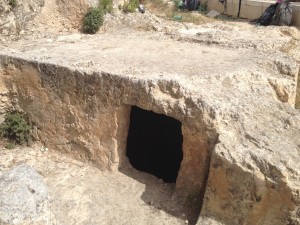The Ketef Hinnom Scrolls and the Antiquity of Scripture
Discovered in 1979 by Gabriel Barkay, the Ketef Hinnom scrolls made news because they contained the text of Numbers 6:24-26 and thus represent the oldest testimony of an Old Testament text that we know about. Funny enough, the discovery of the scrolls took place because the lead archaeologist, Gabriel Barkay, an archaeology professor at Tel Aviv University, told a young boy to go clean up a cave. This young boy ended up hitting the floor of the cave with a hammer (as young boys are wont to do), causing the false floor to collapse and reveal a trove of bones beneath.
This hidden tomb, within walking distance of Jerusalem, had been preserved from tomb raiders and so revealed its treasures to the archaeologists working the scene. The tomb complex found at Ketef Hinnom followed the Old Testament burial practices (basically from Abraham’s time to around 522 B.C.). The procedure of Old Testament (aka First Temple) burial practice was to place the dead corpse on a shelf until it decomposed (usually a year or two). Then, upon returning to the tomb where the body had decomposed, the bones would then be discarded into a burial chamber beneath the shelves along with the bones of others from the family.
This First Temple burial procedure is contrasted with the common Second Temple burial practice (522 B.C. through 70 A.D.), where bodies that had decomposed over the year would be put inside an individual bone box (called an ossuary), which would then be put on a shelf.
What makes the discovery at Ketef Hinnom so unique is that among the bones that were discovered, there was a silver amulet (which had been buried with one of the corpses). Inscribed upon this amulet was the text Numbers 6:24-26. Scholars have used paleography (study of letter writing) to date this amulet to the 6th or 7th century B.C.

The significance of this find should not be lost. Historically, many of the critical and liberal Bible scholars had proposed that the Old Testament developed humanistically in the more recent past. Although the Bible claims Moses wrote the Pentateuch around 1400 B.C., liberal scholars regularly would implement the JEPD theory. This theory espoused the idea that there were at least four documents that were redacted into one large document. One of these four documents was called the Priestly Document (the P of JEPD), and was dated to 500 or 400 B.C. Anything that has to do with an organization of the priesthood or the rigors of organized religion is usually associated with this document.
However, the Ketef Hinnom amulet showed that Numbers 6:24-26, the Aaronic, priestly benediction was far earlier than 400 B.C., causing significant problems to the JEPD theory. This comes as no surprise to those of us who hold to the Bible as true, inspired, and inerrant Word of God. The Bible says Moses wrote those words around 1400 B.C. Although it is not necessary to prove the truth of the Bible, it is welcome to see external evidence that supports what the Bible says is true. Furthermore, the evidence from Ketef Hinnom also demonstrates that the Scriptures were loved and cherished by others, even thousands of years ago.
